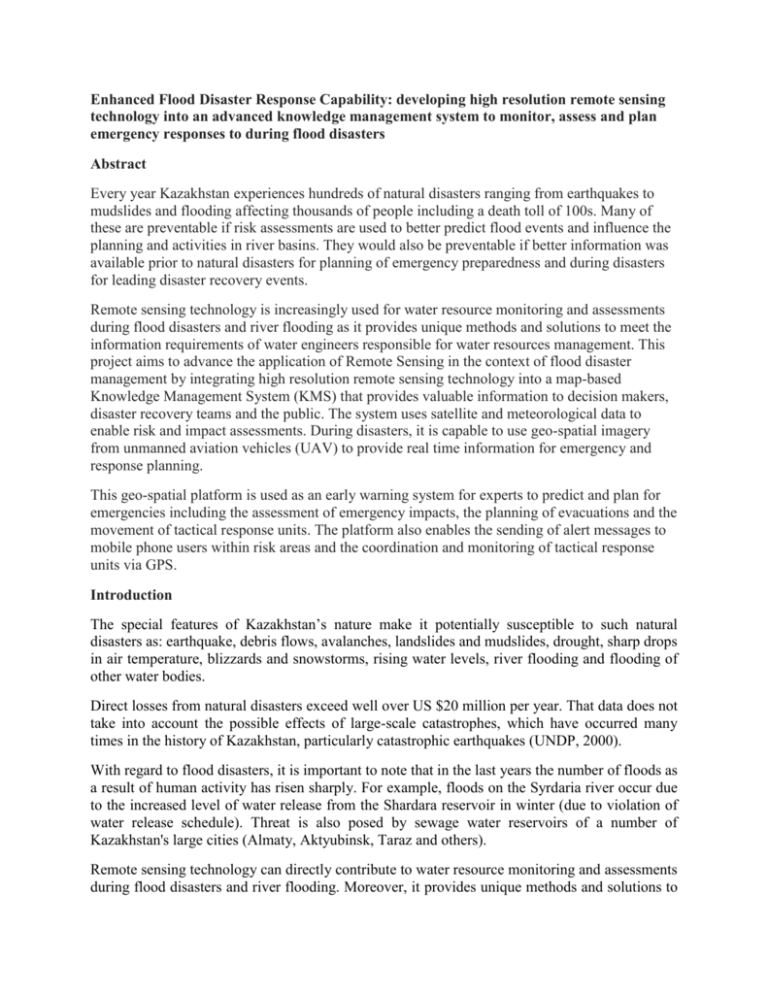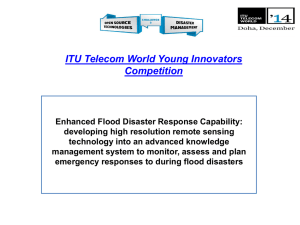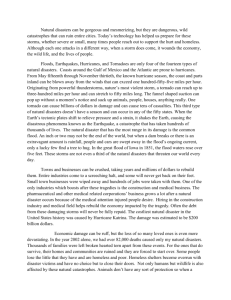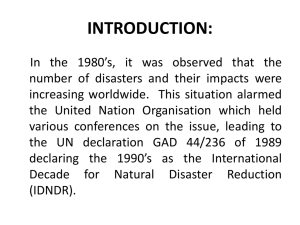Enhanced Flood Disaster Response Capability: developing high
advertisement

Enhanced Flood Disaster Response Capability: developing high resolution remote sensing technology into an advanced knowledge management system to monitor, assess and plan emergency responses to during flood disasters Abstract Every year Kazakhstan experiences hundreds of natural disasters ranging from earthquakes to mudslides and flooding affecting thousands of people including a death toll of 100s. Many of these are preventable if risk assessments are used to better predict flood events and influence the planning and activities in river basins. They would also be preventable if better information was available prior to natural disasters for planning of emergency preparedness and during disasters for leading disaster recovery events. Remote sensing technology is increasingly used for water resource monitoring and assessments during flood disasters and river flooding as it provides unique methods and solutions to meet the information requirements of water engineers responsible for water resources management. This project aims to advance the application of Remote Sensing in the context of flood disaster management by integrating high resolution remote sensing technology into a map-based Knowledge Management System (KMS) that provides valuable information to decision makers, disaster recovery teams and the public. The system uses satellite and meteorological data to enable risk and impact assessments. During disasters, it is capable to use geo-spatial imagery from unmanned aviation vehicles (UAV) to provide real time information for emergency and response planning. This geo-spatial platform is used as an early warning system for experts to predict and plan for emergencies including the assessment of emergency impacts, the planning of evacuations and the movement of tactical response units. The platform also enables the sending of alert messages to mobile phone users within risk areas and the coordination and monitoring of tactical response units via GPS. Introduction The special features of Kazakhstan’s nature make it potentially susceptible to such natural disasters as: earthquake, debris flows, avalanches, landslides and mudslides, drought, sharp drops in air temperature, blizzards and snowstorms, rising water levels, river flooding and flooding of other water bodies. Direct losses from natural disasters exceed well over US $20 million per year. That data does not take into account the possible effects of large-scale catastrophes, which have occurred many times in the history of Kazakhstan, particularly catastrophic earthquakes (UNDP, 2000). With regard to flood disasters, it is important to note that in the last years the number of floods as a result of human activity has risen sharply. For example, floods on the Syrdaria river occur due to the increased level of water release from the Shardara reservoir in winter (due to violation of water release schedule). Threat is also posed by sewage water reservoirs of a number of Kazakhstan's large cities (Almaty, Aktyubinsk, Taraz and others). Remote sensing technology can directly contribute to water resource monitoring and assessments during flood disasters and river flooding. Moreover, it provides unique methods and solutions to meet the information requirements of water engineers responsible for water resources management. This project aims to advance the application of Remote Sensing in the context of flood disaster management by integrating high resolution remote sensing technology into a map-based Knowledge Management System (KMS). Remote Sensing Technology used to complement the development of a Knowledge Management System by advancing the remote sensing capability and image processing to near-real time. This capability can be used to monitor and assess a river basin to develop flood extent and predictions. The objective of this research and engineering project is to: Develop a knowledge management system for water resources development and management Integrate remote sensing technology into a knowledge and communication platform In, details, to study the practice of water resource management and information sources as they relate to the river basins in East Kazakhstan Obtain Remote sensing data and develop software algorithms to synthesize hydrological data To conduct research on flood potential of rivers for the development of geospatial flood risk maps This project uses high resolution remote sensing data to develop advanced algorithms for assessing and monitoring water resources for river basin water resource management (Figure 1). The data is provided by Kazakhstan state company ‘KGS’ from its own remote sensing Satellites KazEOsat-1 and KazEOsat-2 or KGS partner’s satellites. The project will use Remote Sensing data procured from a high resolution (1 m panchromatic and 4 m multispectral) remote sensing and it is anticipated that accurate bathymetric measurements can be achieved up to 20 meters and deeper. Figure 1. Development and application of algorithms A conceptual knowledge management framework has been developed to enquire and collect relevant information for flood related disaster management and recovery. The framework was developed by understanding and mapping water resource management and decision making processes. The framework includes nine (9) distinct but interrelated components. These are shown in Table 1. TABLE 1. Components of Water resources knowledge management framework Water resources knowledge management framework Water Resource Strategy and Policy Stakeholder Management Ownership, Responsibility, Authority and Resources Inventory of the water resource and its infrastructure Condition and Performance of a water resource and its infrastructure Valuations and Financial Review Monitoring, Control and Knowledge Management Internal Process Development and Review Risk Assessment, Management, and Emergency Response The Knowledge Management System consists of four parts: wireless sensor network, local server, monitoring service platform and application server which are connected and operated coordinately. They form an integral part of real time data collecting, management of information, comprehensive analysis and supporting planning, and real time control. The previously developed algorithms will be embedded into the software script to integrate (near) real-time monitoring and control into a software platform used to manage water resources and their controlling infrastructure. It can be divided into two parts: central management system and communication system. The central management system includes a monitoring service platform and application server. The monitoring service platform provides real time data collection of various parameters related to water resources management, such as temperature, moisture content (air humidity), water flow rate, water volume, water quality and rain fall. The system analyses the validity of the data before saving it to a central database. It can output the information in a variety of charts or simulation graphs to show trending including short term forecasting or prediction. That involves mathematical modelling using artificial intelligence and context-awareness, based on data that have been collected. Apart from that, the system has built-in decision making, for example activate certain control, or send alert messages, when there is a sudden change in key parameters. The communication system includes both wired and wireless communication. Various sensors are communicating wirelessly with a control terminal (local server that serves as a coordinating focal point) that is located within the coverage area using various standards. Stereoscopic images of an area are used to develop a data elevation model (DEM) of a river bed. The challenge with collecting stereoscopic imagery of the shallow ocean floor is in how light interacts with the water interface. At high angles of incidence, light is completely reflected off the water surface thus preventing any sub-aquatic profiles from being observed. In this application, sensors are required to collect enough high-resolution stereoscopic imagery within the narrow angle to penetrate the surface of a water body. Furthermore, once these very high resolution images analyzed, this data will be put into KMS. Therefore, based on imagery data web-based software it would be possible to predict flood extent and send ‘warning messages’ to residents living nearby a water body. It is crucial to integrate local knowledge, GIS and maps into the process of disaster risk management. There are three main reasons for this integration: (i) a hazard map plays a key role in disaster risk identification, and it is an effective tool in making local knowledge visible; (ii) local knowledge is essential for disaster risk management; and (iii) GIS maps have advantages over conventional maps. First, hazard maps are fundamental to the development of a communitybased methodology for collecting and displaying the disaster vulnerabilities and risks that comprise the core content of local knowledge (Hatfield,2006). Hazard mapping is one of the first steps of producing a community vulnerability inventory. The flood disaster mapping can contribute to proper planning and resource allocation for disaster preparedness. With the mapping and geo-spatial analysis of information as a basis, it is anticipated that the integration of real-time monitoring provides a comprehensive knowledge management systems to support water resource management and environmental engineering decision making processes in regulatory and public agency organizations. It is anticipated that the development of a real-time online monitoring and assessment capability based on genetic algorithms and statistical pattern recognition has potential to find significant, customized application to advance the management of water resources and environmental systems by enabling real time and remote monitoring of physical and hydraulic attributes of water resources. Once we have a prototype of the web-based software application established, we will register a Limited Liability Company that will offer a web-based software and data subscriptions to our customers. Currently, we are targeting one particular client segment: any government agency involved in water resources management. Further information on Commercialization part, Team and Fee Calculation can be found in a separate file.






